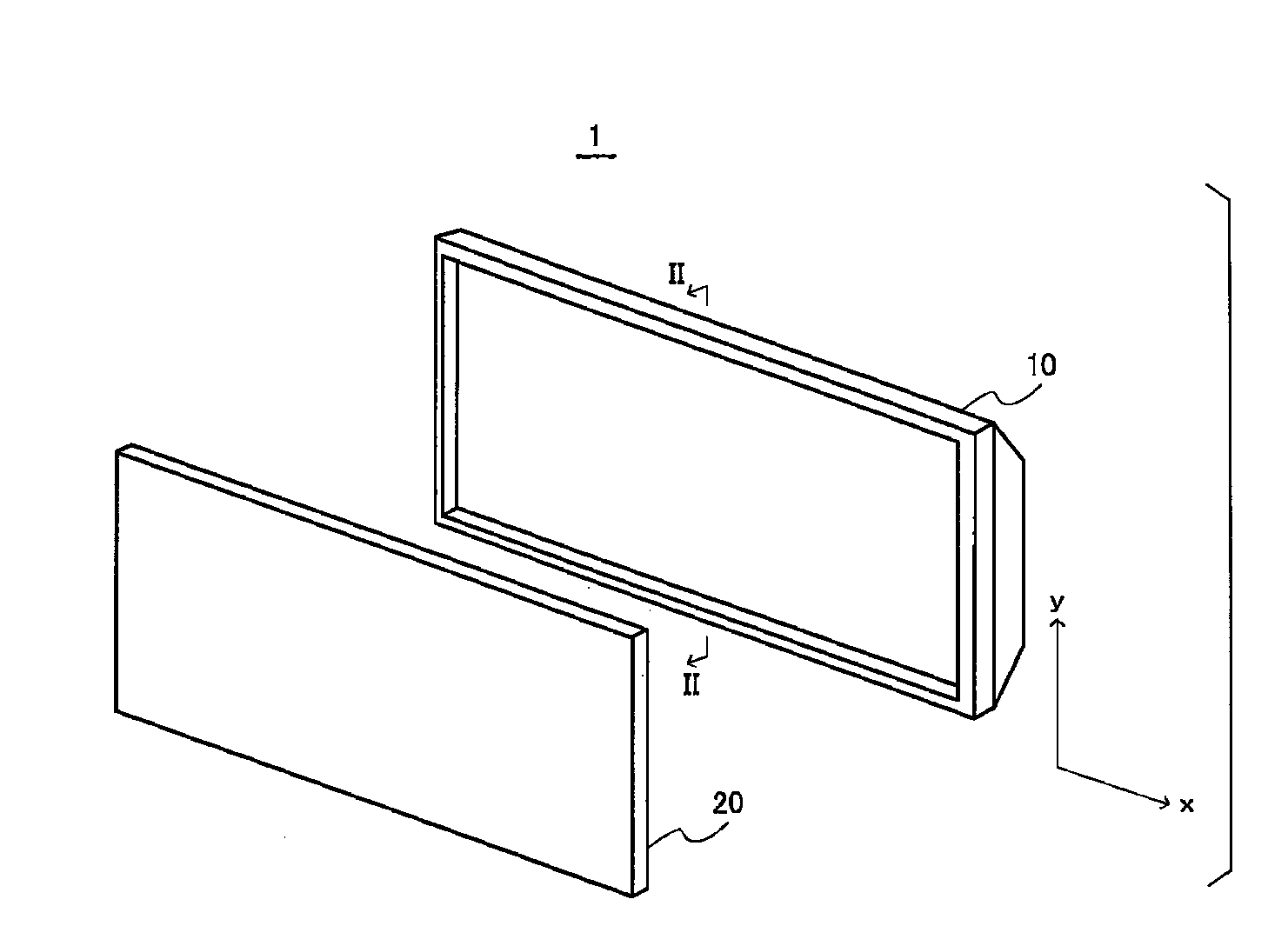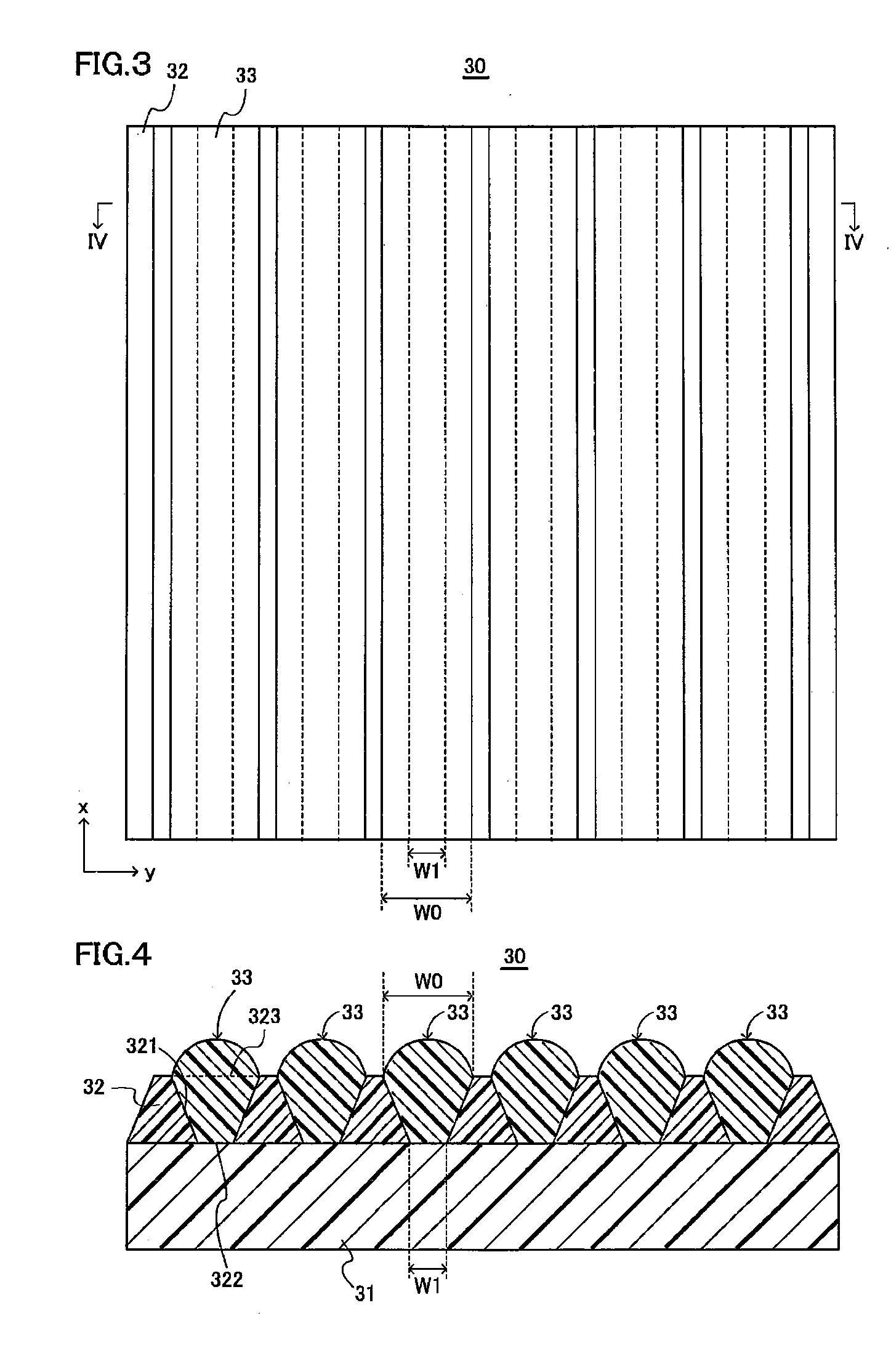Optical sheet for backlight, backlight, and display device
a technology of optical sheets and backlights, applied in the field of optical sheets for backlights and backlights, can solve the problems of bright point or dark point on the display, triangular cross section of the prism pl, easy damage to the display, etc., and achieve the effect of improving the front side brightness, reducing the number of side lobes, and restrainting the side lobe ligh
- Summary
- Abstract
- Description
- Claims
- Application Information
AI Technical Summary
Benefits of technology
Problems solved by technology
Method used
Image
Examples
first embodiment
[0095]An optical sheet (lenticular lens sheet) according to Inventive Example 1 in a shape as shown in FIGS. 3 and 14 and a prism sheet according to a comparative example were produced and examined for their angular distributions of brightness.
[0096]Manufacturing Method
[0097]The optical sheet according to Inventive Example 1 was produced by the following method. To start with, a concave roll plate having a plurality of grooves arranged in the axial direction and extending in the circumferential direction was prepared. The cross sectional shape of grooves in the concave roll plate was a trapezoid, the bottom width was 10 μm, the upper width was 30 μm, the groove depth was 30 μm, and the pitch of the grooves was 50 μm.
[0098]The grooves of the thus prepared concave roll plate were filled with ultraviolet curing resin containing 40 parts by weight of titanium oxide particles. A polyethylene terephthalate (PET) film 310 as thick as 100 μm was prepared as a transparent substrate. The ultr...
second embodiment
[0109]An optical sheet (micro-lens array) according to Inventive Example 2 in a shape shown in FIGS. 12 and 16 were produced and examined for the angular distribution of brightness.
[0110]Manufacturing Method
[0111]The optical sheet according to Inventive Example 2 was produced by the following method. To start with, a PET film 510 as thick as 188 μm was prepared as a transparent substrate. Using a rotary screen plate in a rectangular mesh pattern in which the pitch was 200 μm and the line width was 120 μm, ink produced by having 75 parts by weight of titanium oxide and 25 parts by weight of acrylic resin dispersed in toluene was screen-printed on the PET film 510, and an optical reflection layer 520 having a plurality of through holes was formed.
[0112]Then, the upper surface of the optical reflection layer was provided with a fluorine-based moisture proof coating (HANARL®FZ-610C manufactured by Kanto Kasei Ltd.) 540. After being provided with the coating 540, ultraviolet curing resin...
third embodiment
[0117]Various optical sheets (lenticular lens sheets) in Table 1 having the sizes shown in FIG. 18 was produced while the height h between the top of the cylindrical lens and the lower opening of the through hole was changed and examined for their front side brightness.
TABLE 1height hEX0 = h / test No.(μm)(nr / (n − 1))137.30.72480.93500.93453.31558.71.1669.31.37801.5
[0118]With reference to Table 1, the value for EX0 was produced by the following Expression (2):
EX0=h / (nr / (n−1)) (2)
where n, the refractive index of a cylindrical lens was 1.54 (n=1.54), and r, the radius of curvature of the cylindrical surface of the cylindrical lens was 20 μm as shown in FIG. 18.
[0119]With reference to Table 1, for optical sheets Test Nos. 2 to 6, EX0 was in the range from 0.8 to 1.3 and all satisfied Expression (1). The value for EX0 for optical sheet Test No. 1 was 0.7, and the height h was less than the lower limit for Expression (1). The value for EX0 for optical sheet Test No. 7 was 1.5 and the heig...
PUM
| Property | Measurement | Unit |
|---|---|---|
| width | aaaaa | aaaaa |
| refractive index | aaaaa | aaaaa |
| radius of curvature | aaaaa | aaaaa |
Abstract
Description
Claims
Application Information
 Login to View More
Login to View More - R&D
- Intellectual Property
- Life Sciences
- Materials
- Tech Scout
- Unparalleled Data Quality
- Higher Quality Content
- 60% Fewer Hallucinations
Browse by: Latest US Patents, China's latest patents, Technical Efficacy Thesaurus, Application Domain, Technology Topic, Popular Technical Reports.
© 2025 PatSnap. All rights reserved.Legal|Privacy policy|Modern Slavery Act Transparency Statement|Sitemap|About US| Contact US: help@patsnap.com



